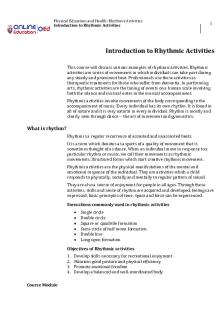Physical – lecture 3 PDF

| Title | Physical – lecture 3 |
|---|---|
| Course | Foundations of Physical Chemistry |
| Institution | Cardiff University |
| Pages | 3 |
| File Size | 97.3 KB |
| File Type | |
| Total Downloads | 9 |
| Total Views | 136 |
Summary
Prof Harris lecture 3...
Description
Physical – 29/1/16 1.5 liquification of gases: Consider a real gas in a piston at constant temperature, what is the relationship between volume and pressure? (1)At sufficiently high temperatures:
Pre ssu re
Volume (2)At lower temperatures, liquification occurs as pressure is increased: [insert graph]
(i) (ii) (iii) (iv)
(v)
A line of constant T, in a P-V graph is called an ‘isotherm’
A-B: low pressure ideal gas behaviour B-C: deviations from ideal gas occur as pressure is increased At C: first drop of liquid is observed (ie. See an interface) C-D-E: liquid and gas co-exist in equilibrium In this region, pressure does not change but volume decreases as the amount of liquid increases from C-E. E-F: only liquid present
Further increase in pressure gives only small changes in volume, due to the low compressibility of liquids. Now consider isotherms at different values of constant T: [insert graph] Point X = the ‘critical point’, characterized by the ‘critical constants’ Tc, Pc, Vc Moving along the ‘critical isotherm’ (at temperature Tc) no visible liquid phase is found If TTc, it is not possible to liquefy the gas (irrespective of pressure) If TTc: (a) (b) (c)
Liquid and gas have identical properties, hence We cannot distinguish liquid and gas for T>Tc, and We refer to this phase as SUPER CRITICAL FLUID
Summary: The P-V phase diagram for a liquid/gas [insert graph] 1.6 Properties of Gases at the Molecular Level: 1.6.1 Kinetic Theory of Gases Consider an ideal gas with molecules in independent random motion at a given temperature T: Kinetic theory explains the motion of molecules in the gas, and allows various average properties to be predicted: (1)Average speed of molecules: Root-mean-squared speed (Crms) is: Crms=
√
3 RT Mm
Where Mm = molar mass (Kg mol-1)
2
Thus for a specific gas, Crms ∝√ T
comparing different gases at a given T:
√
Crms ∝
1 Mm
(2)Average kinetic energy: Average EK per mole of gas: 3 RT 1 1 2 E K = M m (C rms) = M m × Mm 2 2 3 E K = RT 2
(3)Pressure: from the kinetic theory, the pressure of n moles of gas in volume V: p=
n M m (C rms)2 3V
However, Kinetic theory also gave an expression for C rms: Crms=
√
3 RT Mm
So we can derive: p=
n M m 3 RT nRT × = V Mm 3V
ie., equation of state for an ideal gas. Thus, the kinetic theory (based on the assumptions of an ideal gas) is fully consistent with the equation of state for the ideal gas.
3...
Similar Free PDFs

Physical – lecture 3
- 3 Pages

Lecture notes, Physical Geography
- 14 Pages

3. 3. 4. Physical Identification
- 31 Pages

Chapter 3 Physical Evidence
- 3 Pages

Physical Science Module 3-Edited
- 24 Pages

Physical Education 3 4 Notes
- 59 Pages

Lecture notes, lecture 3
- 8 Pages

Lecture notes, lecture 3
- 5 Pages
Popular Institutions
- Tinajero National High School - Annex
- Politeknik Caltex Riau
- Yokohama City University
- SGT University
- University of Al-Qadisiyah
- Divine Word College of Vigan
- Techniek College Rotterdam
- Universidade de Santiago
- Universiti Teknologi MARA Cawangan Johor Kampus Pasir Gudang
- Poltekkes Kemenkes Yogyakarta
- Baguio City National High School
- Colegio san marcos
- preparatoria uno
- Centro de Bachillerato Tecnológico Industrial y de Servicios No. 107
- Dalian Maritime University
- Quang Trung Secondary School
- Colegio Tecnológico en Informática
- Corporación Regional de Educación Superior
- Grupo CEDVA
- Dar Al Uloom University
- Centro de Estudios Preuniversitarios de la Universidad Nacional de Ingeniería
- 上智大学
- Aakash International School, Nuna Majara
- San Felipe Neri Catholic School
- Kang Chiao International School - New Taipei City
- Misamis Occidental National High School
- Institución Educativa Escuela Normal Juan Ladrilleros
- Kolehiyo ng Pantukan
- Batanes State College
- Instituto Continental
- Sekolah Menengah Kejuruan Kesehatan Kaltara (Tarakan)
- Colegio de La Inmaculada Concepcion - Cebu







